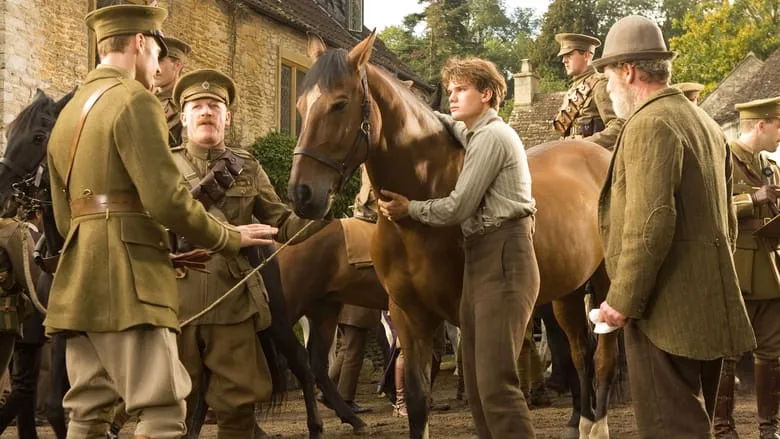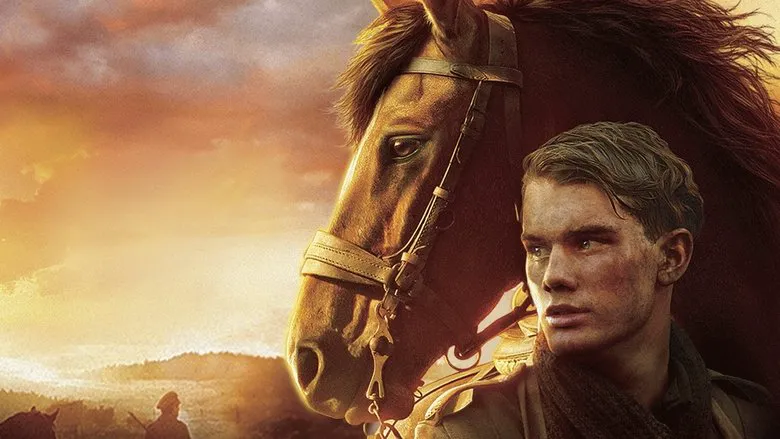War Horse: A Timeless Tale of Friendship and Hope
“War Horse” is a boldly and delicately crafted family film in the finest Hollywood tradition. Be warned: whether you love horses or not, bring at least four tissues to the theater.
Set in England in 1914, the story follows a Devon farm boy named Albert Narracott (played by Jeremy Irvine) who tames and trains a spirited farm horse, whom he names Joey. A deep bond forms between the boy and his horse. However, when hard times strike, Joey is sold to the British cavalry, embarking on an adventure through the battlefields of France during World War I. Driven by unwavering loyalty, Albert sets out on a perilous journey to find his beloved friend.

A Nod to Cinematic History
In 2012, several films vied for awards by intertwining themselves with the history of cinema. Michel Hazanavicius’ “The Artist” transported us back to 1927, celebrating the grandeur of silent film and illustrating the transformative impact of sound. Martin Scorsese’s “Hugo” unfolds in the 1930s, exploring the birth of cinema, the advent of lighting technology, and the magic of Georges Méliès. While Steven Spielberg’s “War Horse” doesn’t explicitly reference filmmaking, it’s undeniably a film steeped in cinematic tradition. In his directorial debut under the Disney banner, Spielberg embraces the aesthetics of the late 1930s and 40s, creating a film that Uncle Walt himself would have been proud of.

Spielberg’s Return to Roots
While “The Adventures of Tintin” showcased Spielberg’s fascination with cutting-edge film technology, “War Horse” sees the director revisiting his roots, drawing inspiration from the films he cherished in his youth at the Kiva Theater in Phoenix. This isn’t mere imitation, however. Spielberg aligns himself with his cinematic idols, including John Ford, David Lean, Frank Capra, and Victor Fleming, but he doesn’t simply mimic them. He works within the traditions of the old school, infusing them with his own dynamic energy and cinematic intelligence. “War Horse” might not be as complex as some of his other works, such as “Saving Private Ryan” or “Munich,” but his direction is masterful, the craftsmanship is impeccable, and the acting is superb. The result is a film that captivates, moves, and evokes tenderness in the viewer. Not since “E.T. the Extra-Terrestrial” has Spielberg delivered such a genuinely touching film.
A Classic Tale, Brilliantly Retold
Spielberg took a significant risk by basing his screenplay on Michael Morpurgo’s beloved children’s novel from 1982 and Nick Stafford’s stage adaptation, which garnered numerous accolades at the National Theatre in London. The core elements are simple and somewhat old-fashioned: the emotional bond between a boy (Irvine portrays the farm boy with a Luke Skywalker-like innocence) and his animal companion, a farm facing ruin, coming-of-age themes, and an animal in peril. However, Spielberg and screenwriters Lee Hall and Richard Curtis believe in these ideas so wholeheartedly that they never feel trite. There are no postmodern tricks, nor is there any hint of awkwardness or embarrassment – only a complete conviction that these time-tested narrative devices will work exactly as they should.
From Intimate Stage to Epic Screen
The director alters the main narrative thread – in Morpurgo’s novel, Joey narrates his own adventures, while Spielberg refrains from giving the horse a voice – and reconstructs it. He preserves the touching intimacy of the play while imbuing the story with the epic scope characteristic of the big screen. The scale of the war scenes in “War Horse” is immense: a sudden British cavalry charge, led by Major Stewart (Benedict Cumberbatch), erupts from tall grass (strangely reminiscent of the raptor attack in “The Lost World”), and then the equine avalanche sweeps across the open terrain in a style reminiscent of David Lean. When the action shifts to the Somme, Spielberg throws you headfirst into the mud and chaos of no man’s land, but without repeating himself. Unlike “Saving Private Ryan,” where dynamism was achieved through shaky camera work, here the war is not only shown through the eyes of British soldiers. These episodes alternate with more formally shot scenes, using a stationary camera, and these moments – from masterfully edited close-ups of explosions silhouetting soldiers against the flashes to the memorable scene of a raid on a German bunker, bloodless but full of tension – lend a sense of grandeur to the proceedings. The director doesn’t aim to overwhelm the viewer, but the film depicts not only the senseless brutality of war but also the turning point in military history when cavalry was replaced by mechanized warfare. Joey may leap over tanks as if they were the famous Becher’s Brook at the Aintree Grand National, but in “War Horse,” the quiet funeral knell for an outdated way of war is clearly audible.
Spielberg’s Signature Touches
“War Horse” is not just about the shock and awe of war’s horrors. The film is full of typically Spielbergian original touches and nuances: the opening shot is filmed as a reflection in a horse’s eye, a regimental flag becomes a striking leitmotif, and a windmill wheel takes on strategic significance. Fans of daring transitions à la “Tintin…” should watch out for the dissolve in which Albert and Joey seem to be making their way through Emily Watson’s knitting. Given that Spielberg’s collaborations with cinematographer Janusz Kaminski have typically yielded stunning blurred images, “War Horse” may be their most visually striking film. England’s pleasant green landscapes have never been so pleasant and green, and cavalrymen lead their steeds through the blazing sunsets of Europe. However, there is a certain cool delicacy in Kaminski’s work: his shots evoke real and strong emotions in the viewer without ever crossing the line into sentimental saccharine.
Behind the Scenes
- Hats off to Finder, the stallion owned by horse breeder Bobby Lovgren, who portrayed Joey in the film’s key dramatic moments.
- Robert Emms, who played Albert’s rival David Lyons, played Albert himself in the stage production.
- The scenes in no man’s land were filmed in Wisley, a stone’s throw from the pub in “An American Werewolf in London.”
- To reduce the weight of the sabers used in the cavalry charge scene, they were made of bamboo and then chrome-plated.
The magic of the stage production owed much to the astonishing skill of the puppeteers who brought the horses to life. Although Spielberg didn’t have the opportunity to use a similar stage technique, he somehow manages to tell the whole story from the animal’s point of view. After the long opening scenes in Devon, where the close bond between boy and horse is formed, Joey is sent to France, where we remain with him for almost the entire film. Because of this, it seems that, given the importance of Albert’s character in the first act, his war adventures are not given enough attention. Spielberg masterfully handles his four-legged actors – the simultaneous reaction of a herd of horses to the euthanization of their comrade is brilliantly filmed; the same can be said of the strangely touching story of the friendship between Joey and his “fellow soldier” Topthorn. But it’s not just about the acting qualities of the animals. After this film, Spielberg joins the ranks of such great masters of filming horses as John Ford and Akira Kurosawa. Skillful camera movements help to express the animal’s “feelings.” The scenes where Joey, having lost his rider, gallops through the forest or thunders through the night along a trench in no man’s land are expressively filmed from a moving trolley. It is in such moments that Spielberg’s creativity, the camera work, John Williams’s moving music, the art of storytelling, and emotions merge into a single whole, and scenes filled with inspiration arise.
A Journey Through War and Humanity
Joey passes from Albert to Captain Nicholls, embodied by the excellent Tom Hiddleston, from two German brothers (David Kross, Leonhard Carow) to a dying French girl (Celine Buckens) and her grandfather (Niels Arestrup, playing the role with noble solidity), and then to a German horse breeder (Nicholas Bro)… In between cavalry charges, Spielberg finds time and space for human relationships between the characters: a discussion about the cost of a silk cap, a young soldier’s fantasies about Italian girls, and, as the culmination of everything, a funny and touching dialogue in no man’s land between a native of Northern England and a German soldier who stumble upon each other while trying to help Joey, who has become entangled in barbed wire.
The film is not perfect: I would very much like to know more about some of the bright characters. It is also fair to say that the picture would not be harmed by some compactness, and if you do not share the aesthetic concepts of the director and his view of the world, the film is unlikely to make you change your mind. And yet Spielberg has a supernatural gift for anticipating what his audience wants: perhaps in an era of uncertainty and crisis, a simple story about a strong friendship, filled with such an old-fashioned sense of hope, is exactly what will resonate in people’s hearts. The fervor and courageous sincerity of “War Horse” goes against the frivolous irony of our time, but in the end, when the film ends under a sky taken from “Gone with the Wind,” it becomes clear that Spielberg has not uttered a single false word.